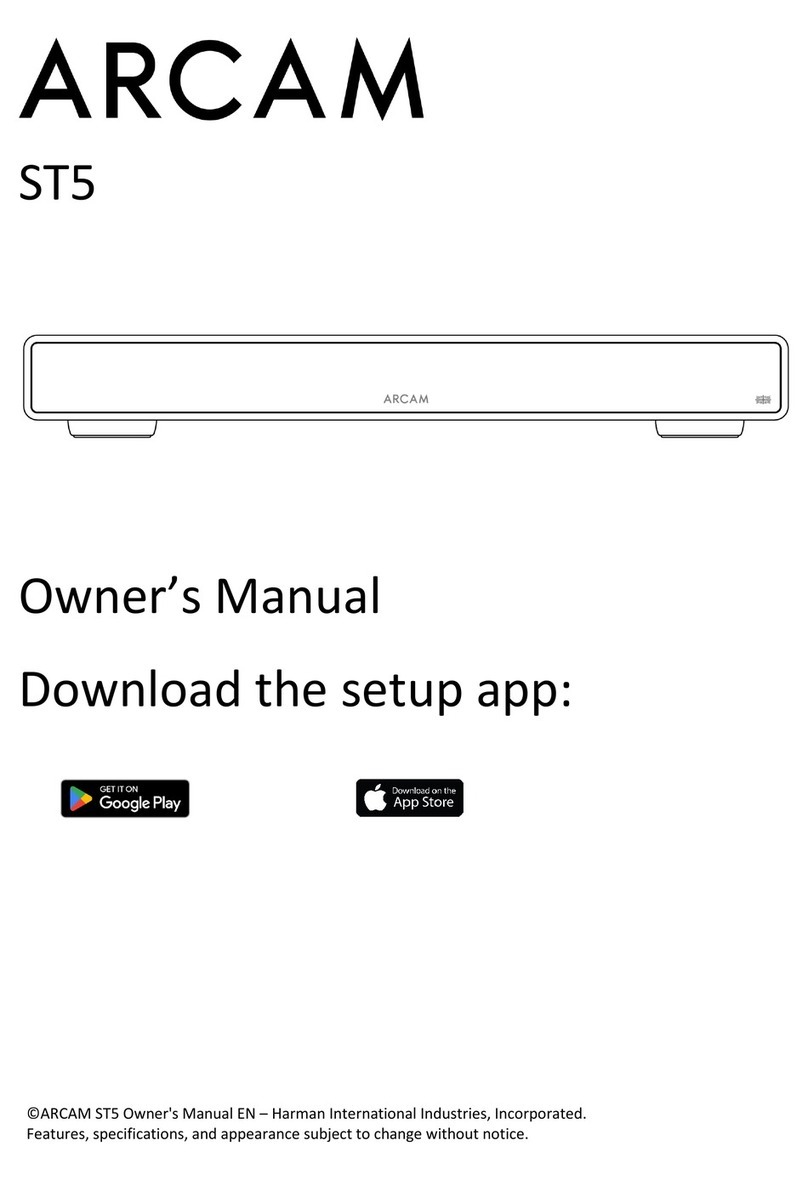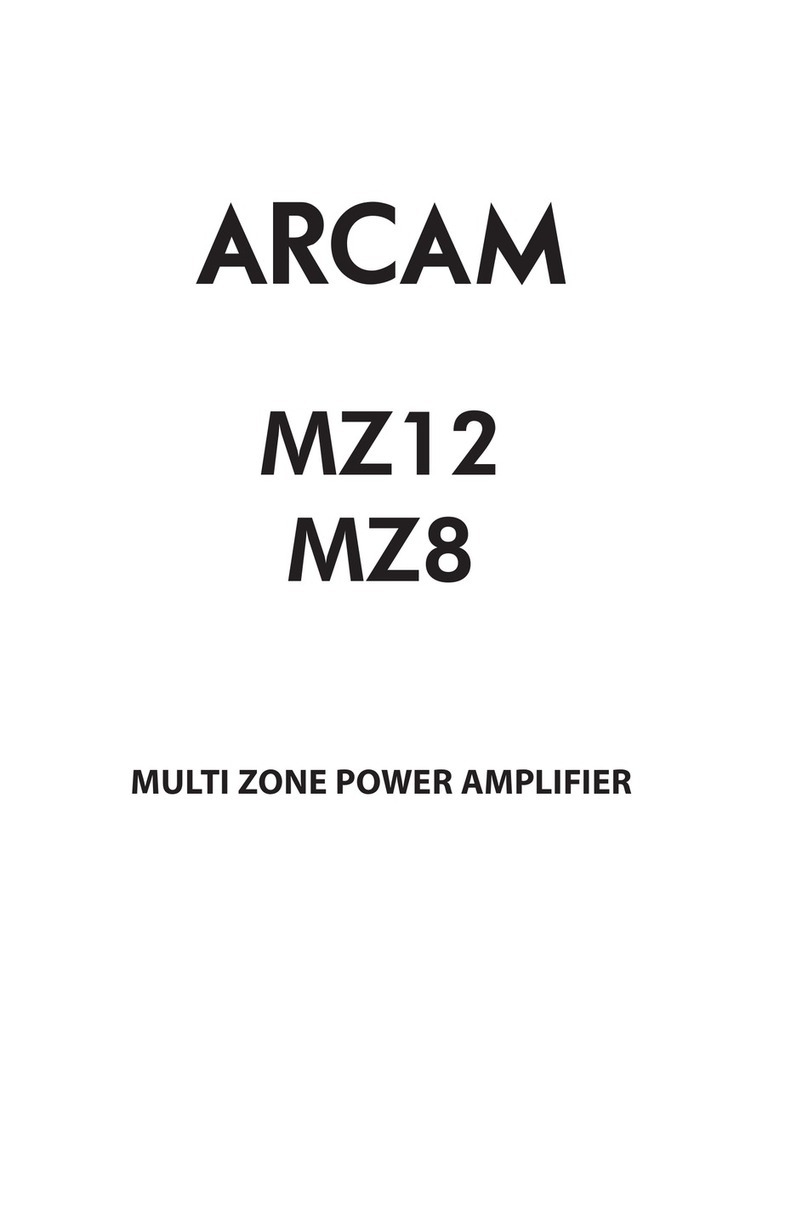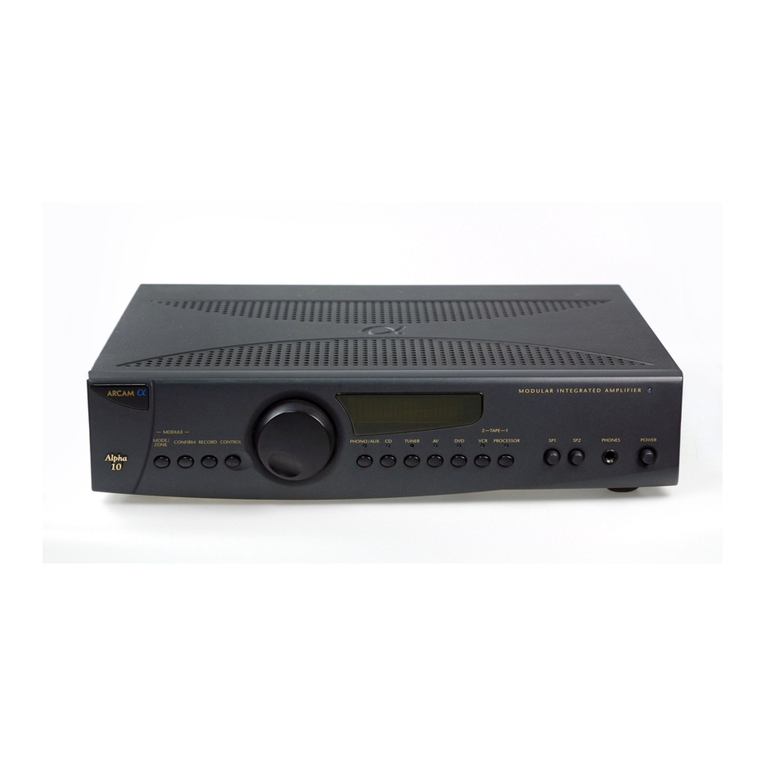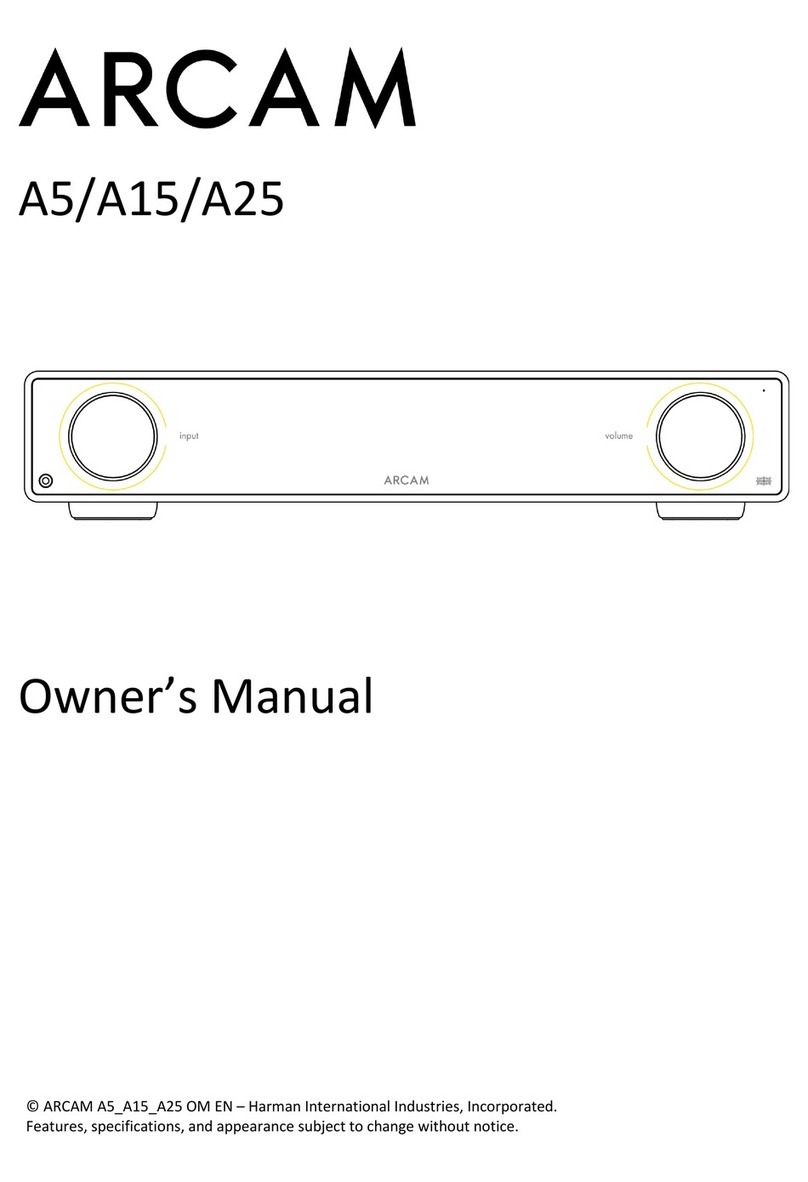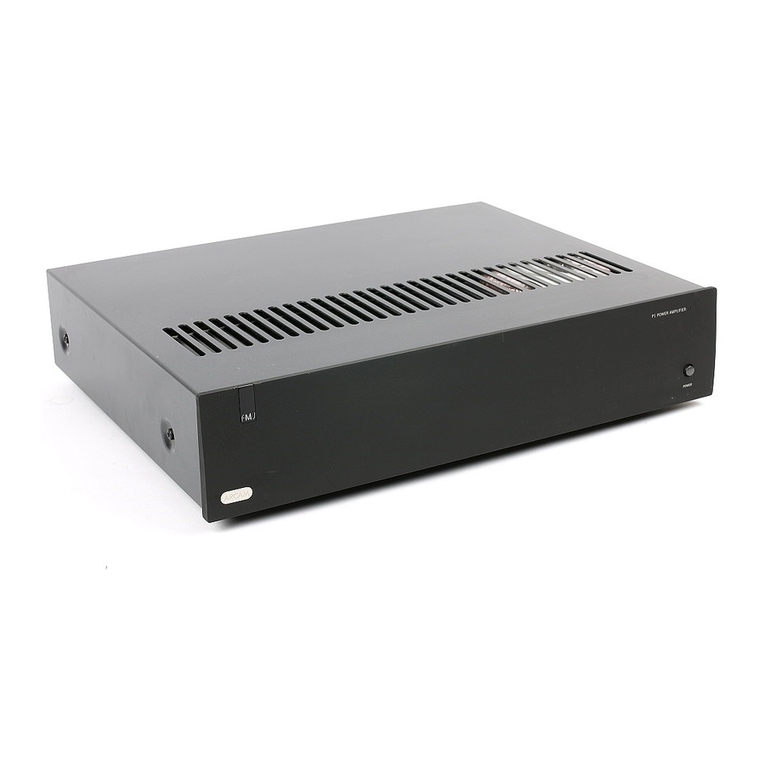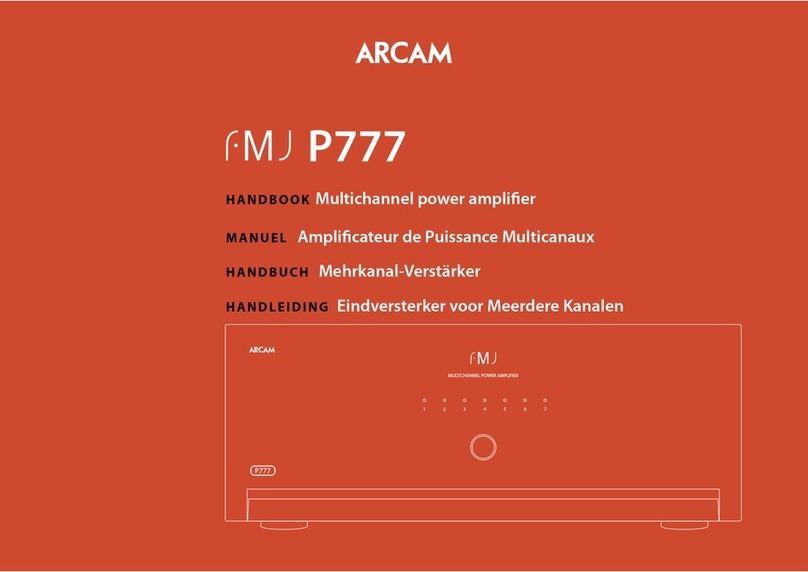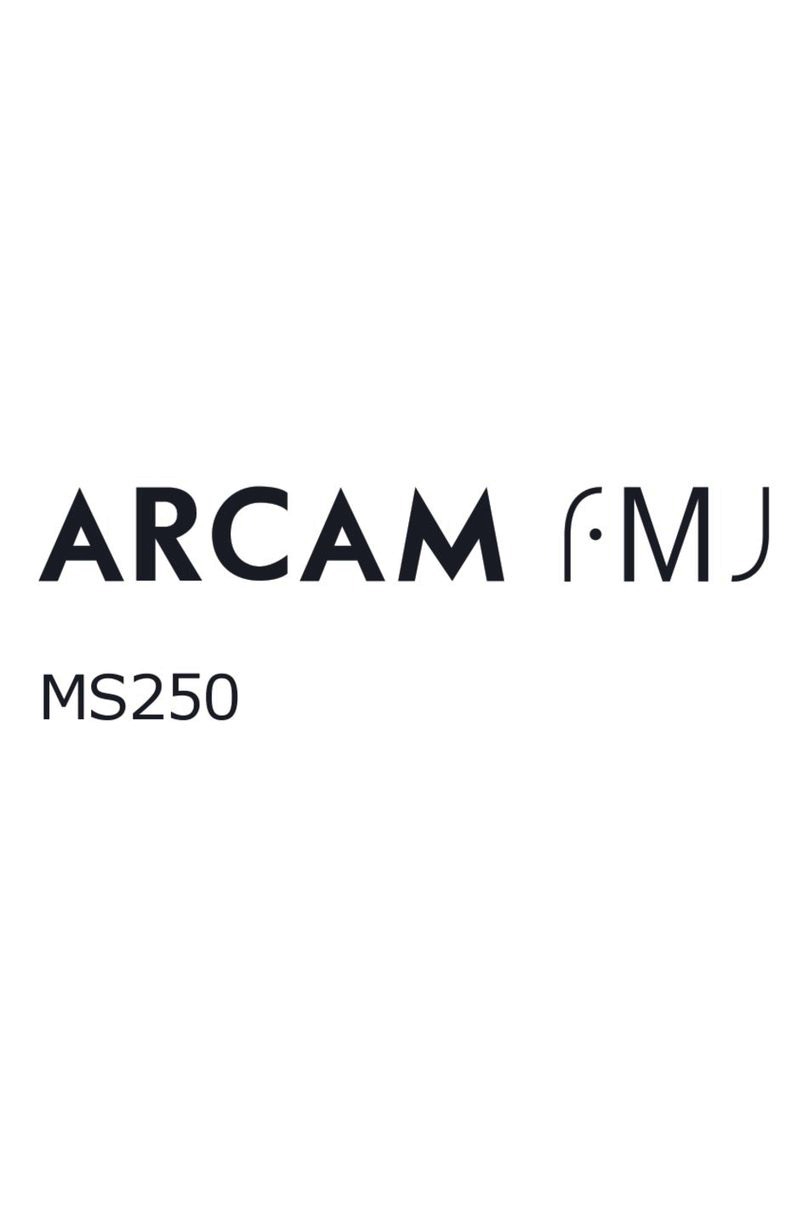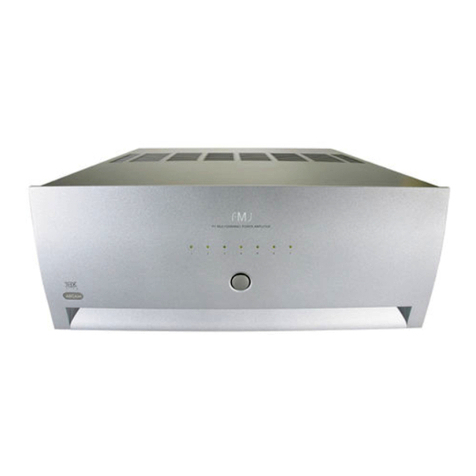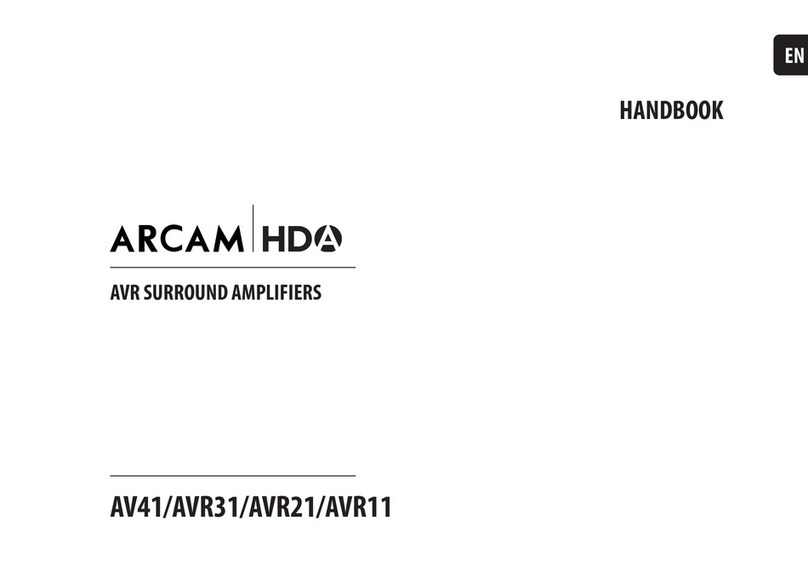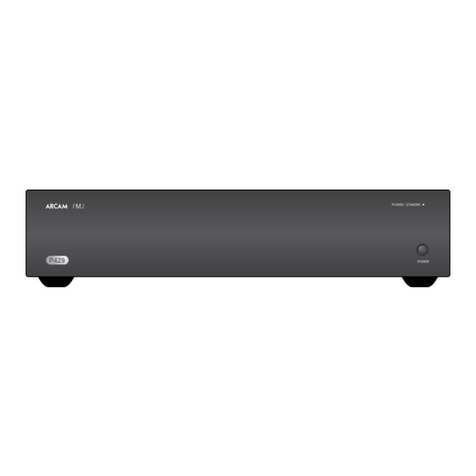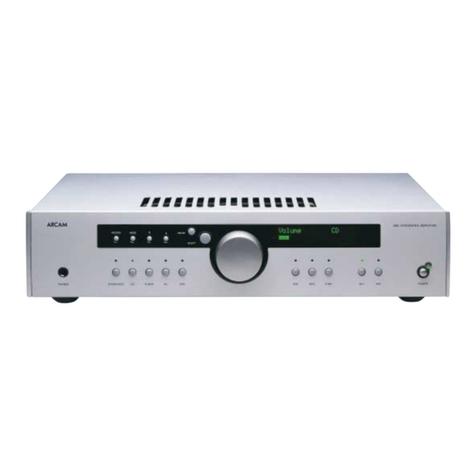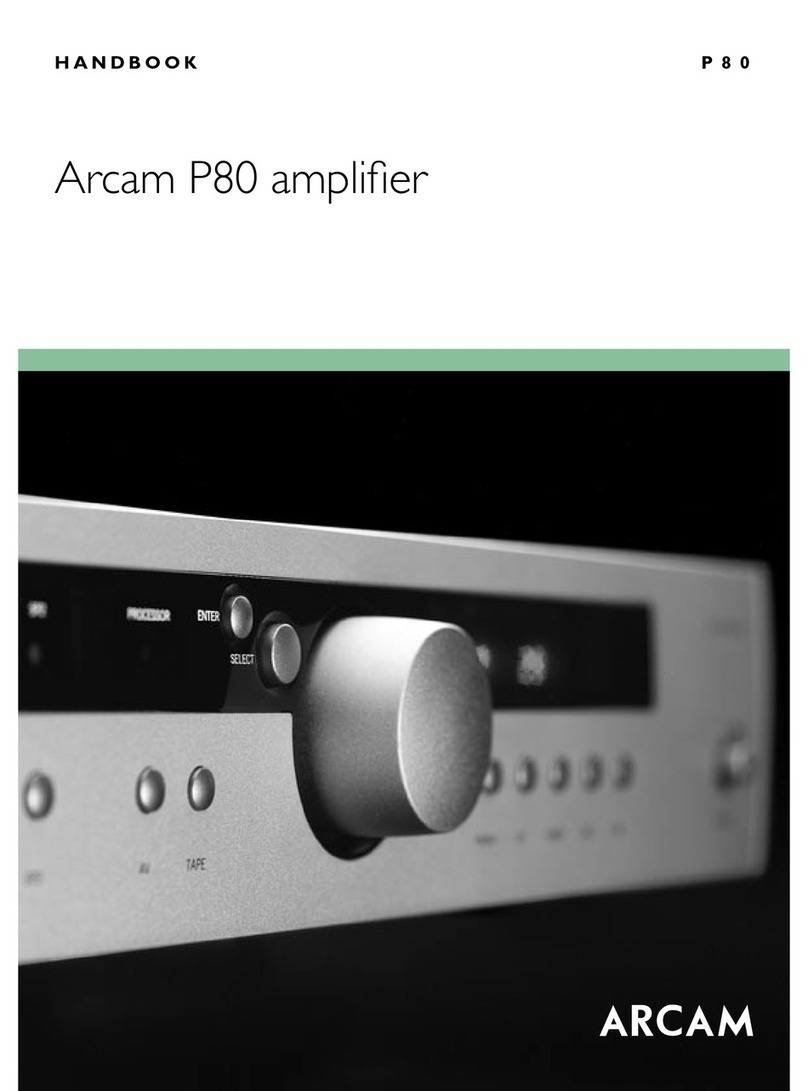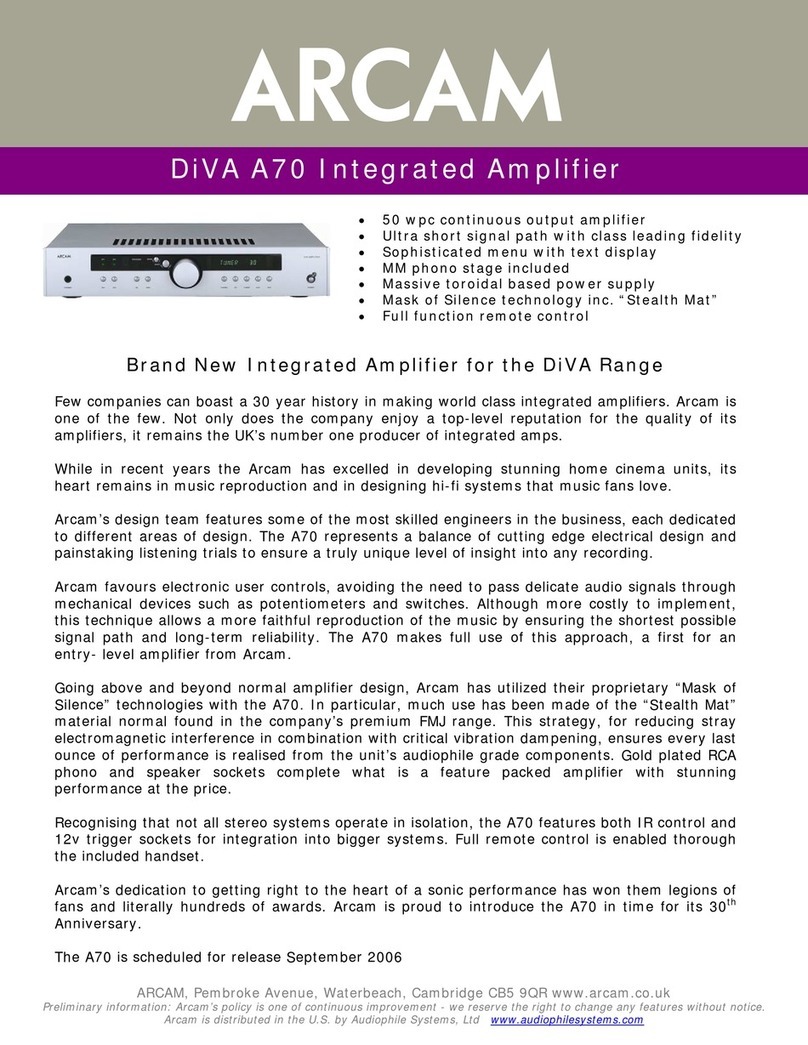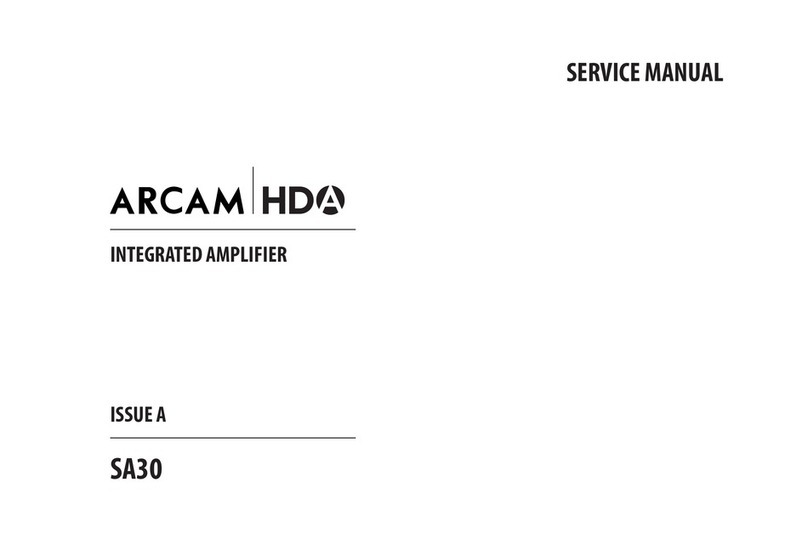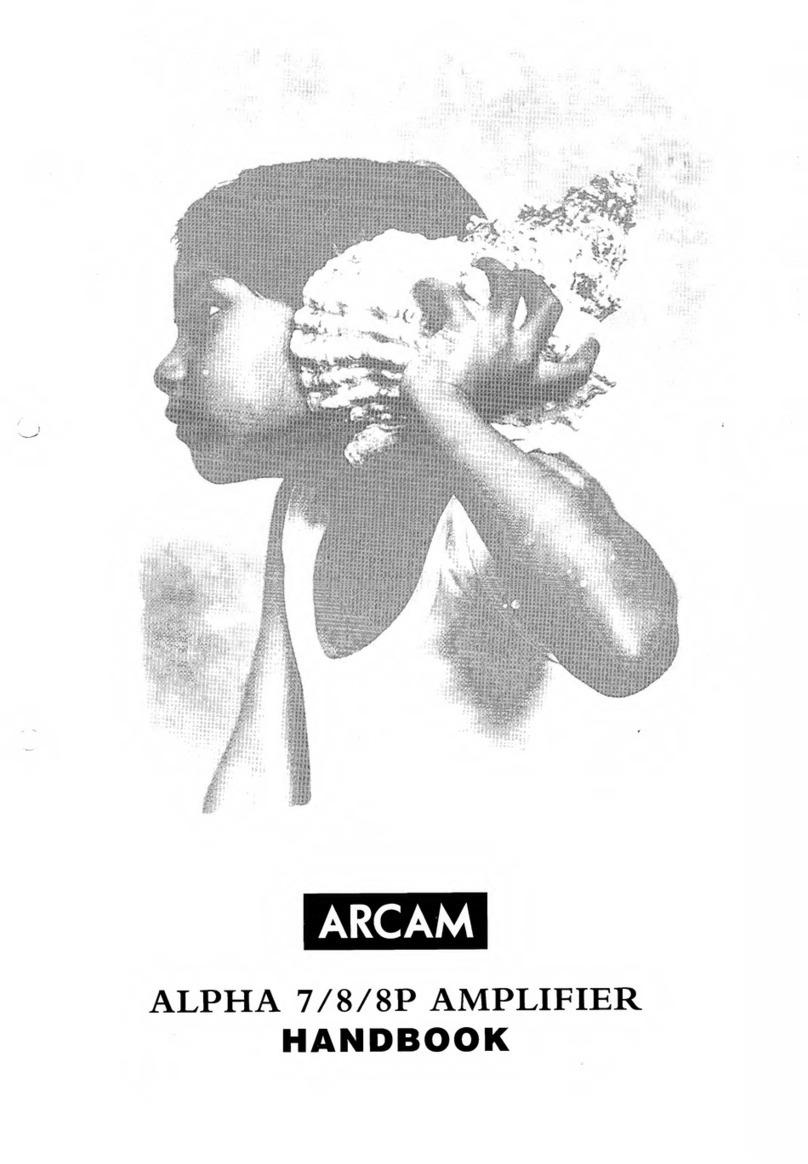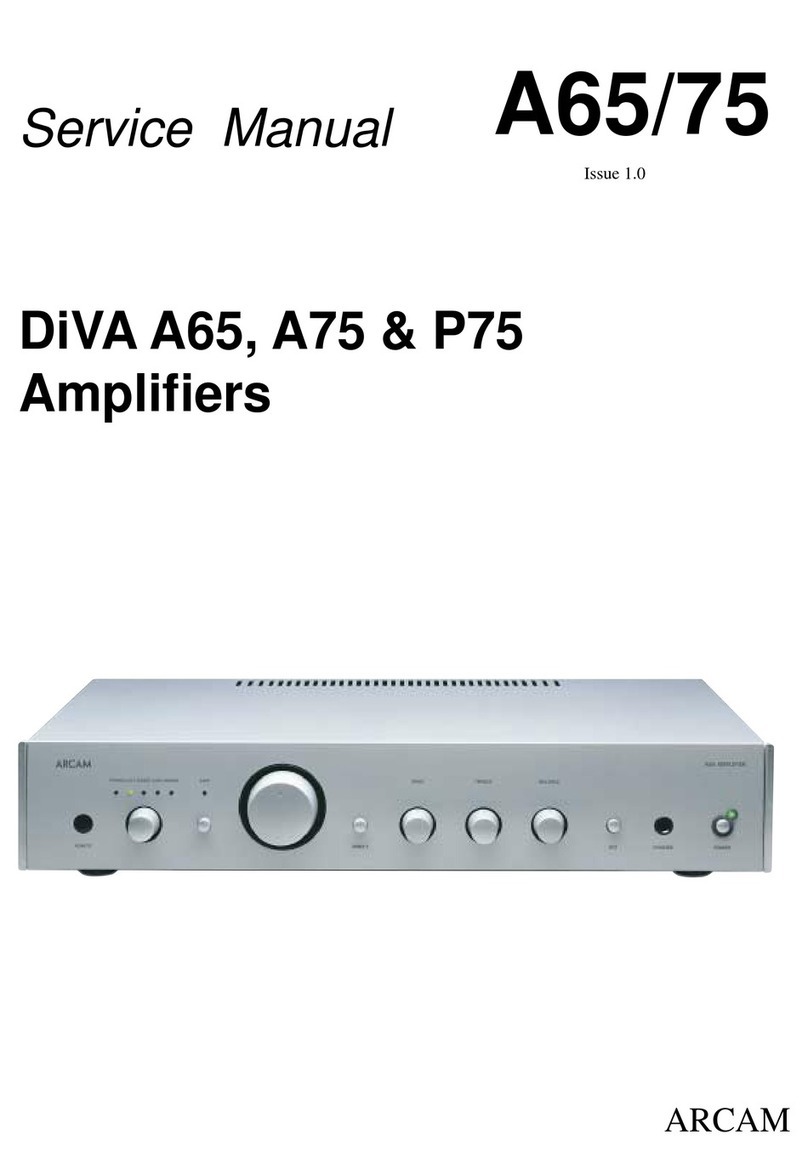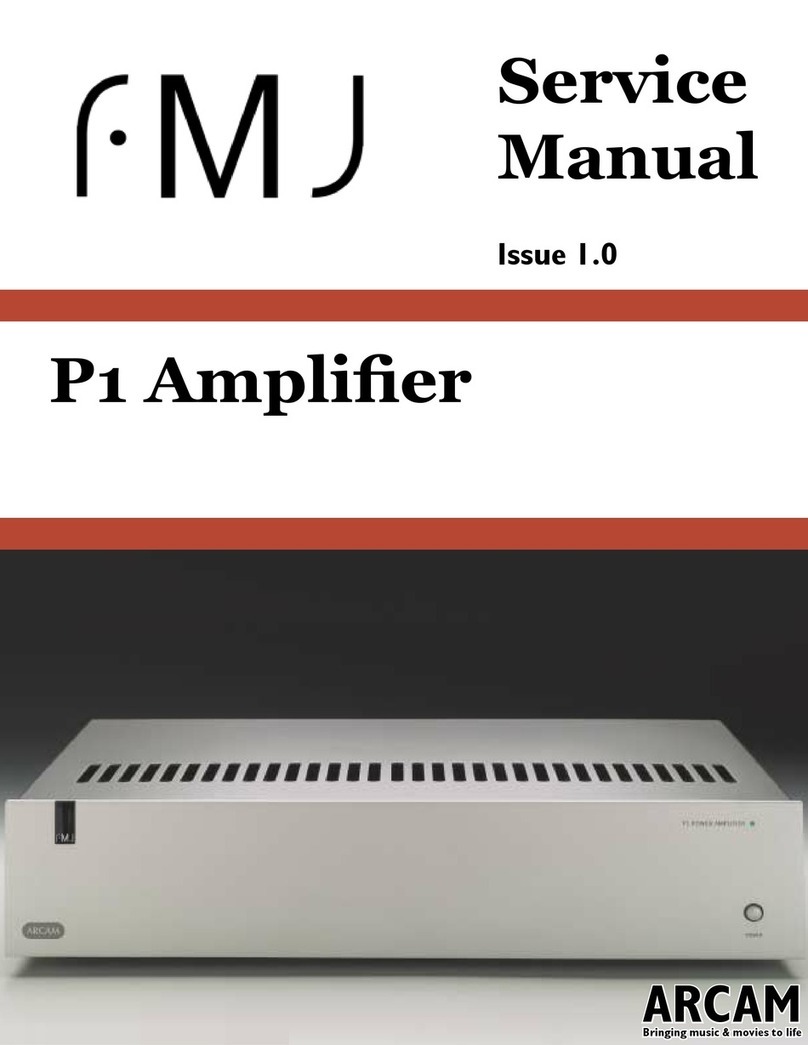Switching on
e POWER button switches the unit on and o.
e power light (next to the ‘POWER / STANDBY’
text) indicates the state of the amplier: it changes from
red to orange then green if mains power is connected
and the unit is switched on.
If the unit is le unused for an extended period of time
it will go into standby to reduce power consumption.
Press AUX and BALANCE to adjust the time of this feature.
Display
e DISPLAY button (or DISP on the remote control)
changes the display brightness between ‘on’, ‘dimmed’
and ‘o’. If the A49/C49 is powered o with the display
brightness set to ‘o’, the display resumes to ‘dimmed’
when the unit is powered on again.
or DAB radio tuner. Note the tuner device page on the
remote will control Arcam tuners.
SAT
Intended for the analogue outputs from a satellite TV
receiver or cable TV box.
BD
Intended for the analogue outputs from a Blu-ray or
DVD-player. Note the BD device page on the remote
will control Arcam BD players.
PVR
Intended for the analogue outputs from a Personal
Video Recorder, or similar device.
AV
Intended for the analogue outputs from general audio-
visual equipment, such as a VCR or digital TV/satellite
receiver.
CD
Intended for the unbalanced analogue outputs from
an Arcam CD player. Note the CD device page on the
remote will control Arcam CD players.
PHONO 20
PHONO AUX CD TUNER SAT
MUTE DISPLAY BALANCE
BD PVR AV SP1 SP2 PHONES
POWER
POWER / STANDBY
Selecting an audio source
Audio sources may be selected from the front panel
buttons (PHONO, Aux, CD, TUNER, SAT, BD, PVR, AV), or the
remote control (PHONO, AUX, CD, TUN, SAT, BD, PVR, AV).
In each case, the source is selected from the input
sockets with the corresponding name.
Audio inputs
Although the inputs are labelled for specic devices, all
have the same characteristics and each may be used with
any line-level product. e exception is the PHONO (MM)
input (see pages20-21 for the specication).
AUX (XLR)
Intended for the balanced analogue outputs from a
source, for example the Arcam D33. e balanced
inputs can also be assigned to any other input key on
the remote. Either use the MENU button on the remote to
access the setup menu, or press the front panel BD and
BALANCE buttons simultaneously and use the control
knob to change the setting. e front panel display shows
(e.g.) XLR CD. In this example, when the CD button on
the remote is pressed, the XLR inputs will be selected. So
the original input is still available, when the AUX button is
pushed, the CD input will be selected.
TUNER
Intended for the analogue outputs from an FM, AM
Phono input
Phono-level input
e A49/C49 provides a pre-amplication stage to treat
the low-voltage output from a MM (moving magnet)
cartridge. Input specications are given on pages 20 - 21.
Output volume is shown on the front display as
PHONO 20, for example.
Line-level phono input
e phono input may be changed from line-level to
phono-level. Either use the MENU button on the remote to
access the setup menu, or press the front panel PHONO
and BALANCE buttons simultaneously and use the control
knob to change the setting. e front panel display shows
LINE- OFF (i.e. phono) or LINE- ON respectively.
If you wish to use an external phono amplier, connect
its output to the PHONO (MM) input, but make sure that
LINE- ON is selected, since a phono amplier produces
line-level input.
With the input dened in this way, output volume is
shown on the front display as LINE- 20, for example.
WARNING: NEVER play a standard line-level source into the
phono input when set to LINE-OFF. This would result in serious
damage to both your amplier and speakers due to the extra
gain that is applied and would not be covered under warranty.
A49/C49
operation
PHONO 20
PHONO AUX CD TUNER SAT
MUTE DISPLAY BALANCE
BD PVR AV PHONES
POWER
POWER / STANDBY
PM 50. When at the default level, a > will be shown just
in front of the level indication.
Connecting to an additional
power amplifier
e A49/C49 provides a pair of unbalanced pre-outs on
standard RCA phono connectors and a set of balanced
pre-outs on XLR connectors to allow connection to
an additional power amplier to create a bi-amplied
setup.
Most audio ampliers, including the Arcam P49/
P349, will connect to the RCA phono connectors
using standard interconnect cables. is connection is
recommended for short cable runs. Connect to the PRE
IN connection of the power amplifer
If however your amplier has balanced connections,
you may use the balanced XLR output. is connection
provides greater rejection from electrical interference
and is useful when cables are long (more than a few
metres) or in electrically-noisy environments. Balanced
connections also have the ability to reject ‘hum’ caused
by ‘ground loops’. Connect to the PRE IN connection of
your power amplier.
Recording an audio source
e A49/C49 allows you to record and monitor the
sound from any connected source.
e back panel REC OUT socket can be connected to the
input sockets of your recording device (these are usually
labelled RECORD or IN).
To record from a particular source, press the
appropriate source button (for example, TUNER).
Adjusting the balance
e balance setting allows you to increase the volume of
one channel (le or right) relative to the other. Altering
the balance may help to restore the stereo image for an
o-centre listening position.
Balance can be adjusted from the front panel or from
the remote control. Press the BALANCE button (or BAL
on the CR902) to view the current setting, then use
the control knob (or the +/ buttons on the remote)
to change the setting – from L9 to R9, via the neutral
value 0.
Speaker Control
e SP1 and SP2 switches (A49 only) enable and disable
the respective speaker outputs. e LED will be lit if the
speakers are enabled.
Listening
Volume control
Use the control knob (or the +/ buttons on the remote)
to change the volume. Turn the knob clockwise to
increase the volume, anti-clockwise to reduce it.
Listening using headphones
e headphones socket (PHONES) accepts headphones
with an impedance rating between 8Ω and 2kΩ, tted
with a 3.5mm stereo jack plug.
e pre-amp outputs and speakers are muted when
headphones are plugged in and the front panel display
shows HEADPHONE.
e headphones socket is always active, unless output
has been muted.
Muting output
e output of the A49/C49 can be silenced by pressing
MUTE on the front panel (or -on the remote control).
If the unit is muted, the power light changes to orange
and the source is shown on the front display panel (e.g.
PVR MT).
Press MUTE/-for a second time (or change the volume)
to cancel mute.
Connecting to a source
component with a balanced
output
In addition to the seven single end (RCA) inputs, the
A49/C49 provides a single balanced input on female
XLR connectors.
If your source component (such as the Arcam D33)
has balanced audio outputs you may wish to use this
connection instead of the single ended inputs. is type
of connection provides greater rejection from electrical
interference and is useful when cables are long (more
than a few metres) or in electrically-noisy environments.
Balanced connections also have the ability to reject
‘hum’ caused by ‘ground loops’.
Processor mode
Processor mode can be assigned to any input. In this
mode, the A49/C49 is set to a xed level. Use MENU
button on the remote and then use the control knob to
change the setting. e front panel display shows (e.g.)
PROC- AV.
When this input is selected, the volume display will show
PM instead of the volume level.
To alter the level use the MENU button on the remote to
access the setup menu then use the control knob to
change the setting. e front panel display shows (e.g.)
